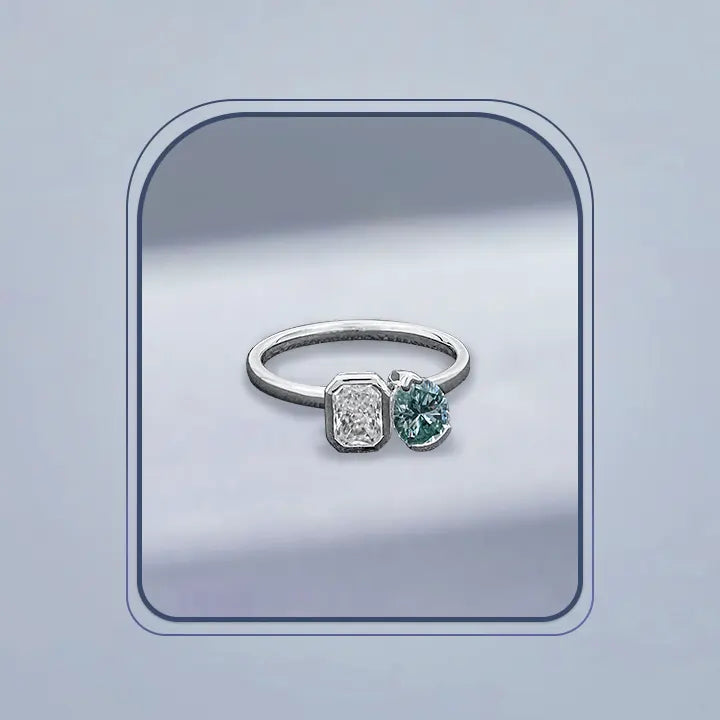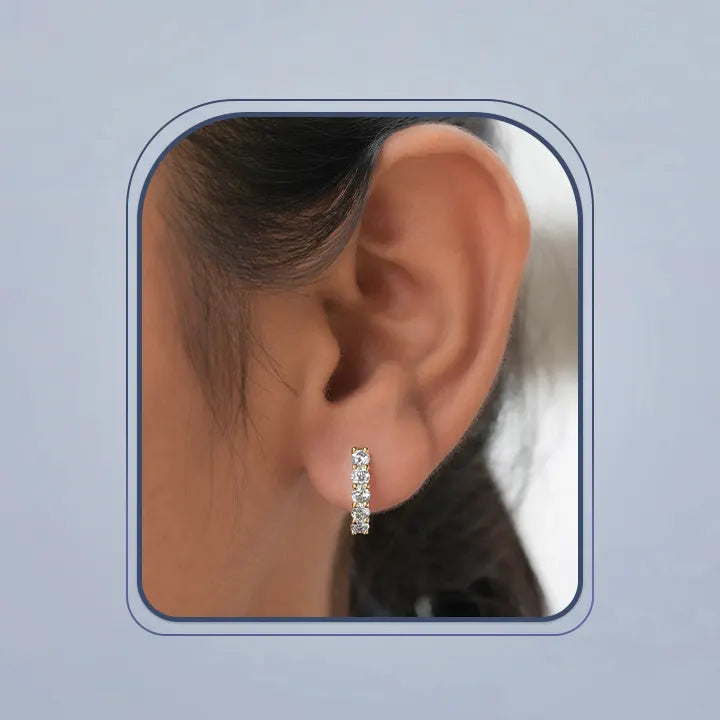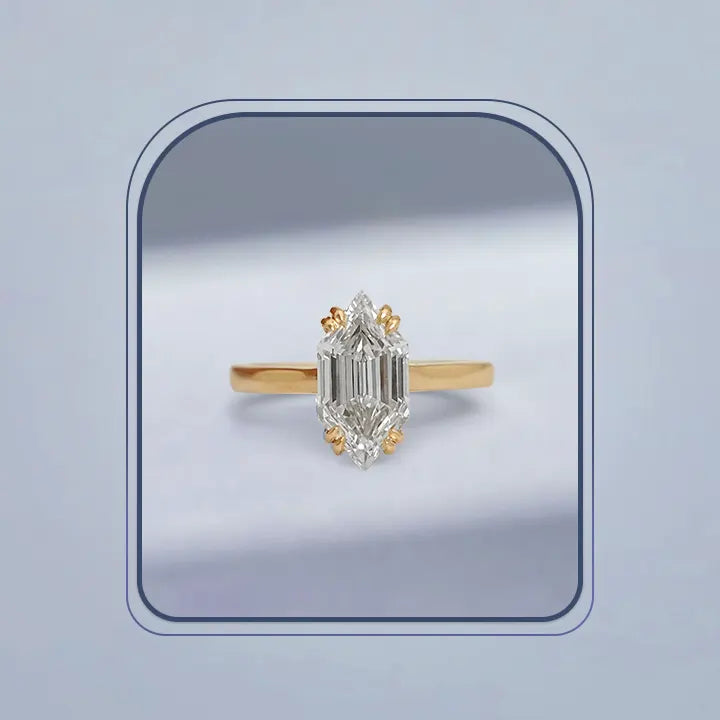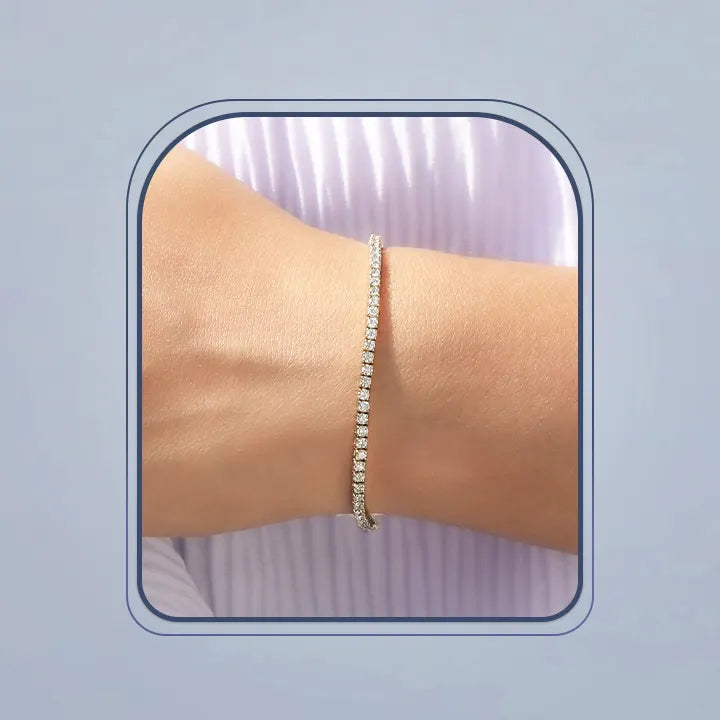Lab-Grown Diamonds VS Natural Diamonds

Diamonds have long been a symbol of love, luxury, and prestige. In the USA, the demand for diamonds continues to grow, with many buyers now considering lab-grown diamonds vs. natural diamonds. With advancements in technology, lab-created diamonds offer an ethical, cost-effective alternative to mined diamonds.
But how do they compare? Are lab-grown diamonds worth it? Should you invest in a natural diamond instead? Let’s explore the key differences between lab diamonds vs. real diamonds to help you make the best choice.
What Are Lab-Grown Diamonds?

Scientists manufacture real diamonds through laboratory processes. They retain every physical characteristic alongside chemical properties and optical elements that exist in natural diamonds. Two methods enable scientists to create lab-grown diamonds: High-Pressure High-Temperature (HPHT) and Chemical Vapor Deposition (CVD).
HPHT puts carbon through natural pressure and heat conditions similar to what occurs in geological processes. A carbon-rich gas deposits diamond layers by operation of the CVD method. Both methods produce high-quality diamonds.
All synthetic diamonds consist only of carbon as their chemical composition. Synthetic diamonds match the hardness and brilliance attributes of diamonds which form naturally inside Earth. Diamonds rank as the hardest material on the Mohs hardness scale because of their position number ten which gives them protective capabilities.
Lab-grown diamonds receive certification services from the main organizations IGI and GIA. Lab-grown diamonds gain their authenticity through these confirmed assessments.
The USA shows increasing popularity for synthetic diamond products in the market. The reason why consumers choose synthetic gems is their reasonable prices alongside their environmentally friendly ethics and ethical production. Such diamonds exist free of all dangerous extraction activities that exist in diamond mining.
An increasing number of jewelry customers prefer lab-created vs. mined diamonds for their engagement rings alongside earrings and other jewelry items. They gain more popularity as the technology enhances while jewelers increase their availability.
What Are Natural Diamonds?

The Earth produces natural diamonds at great depth. The process of forming these diamonds requires hundreds of millions up to billions of years through ultimate heat and pressure conditions. Homemade diamonds become accessible for mining when volcanic eruptions expose them to the Earth's surface.
Each natural diamond is unique. During their formation diamonds naturally develop tiny inclusion marks which remain from their growth period. Because of such natural imperfections they exhibit unique properties. The rarer the diamond, the higher its value.
Natural diamonds receive certification from both the Gemological Institute of America (GIA) and the American Gem Society (AGS). Nonprofit organizations follow a diamond grading system that evaluates cars based on their cut shape together with color appearance, clarity level and weight measure. Certification ensures quality and authenticity.
A natural diamond represents luxury to most people. Natural diamonds remain highly prized because they are rare in the market. Many choose them for engagement rings, heirlooms, and high-end jewelry. Natural diamonds maintain their market value as they do not have the same depreciation as lab-grown diamonds.
People in the USA purchase natural diamonds mainly because of their status value and ancient heritage along with their enduring worth. Natural diamonds represent eternal elegance which people commonly view as signs of wealth and refinement. The purchase of a natural diamond enables a person to acquire a scarce geological artifact from Earth’s past.
Lab-Grown vs. Natural Diamonds: Key Differences

The distinctions between the two diamond types enable buyers to choose more effectively.
Price Comparison
The cost between lab-created vs. mined diamonds extracted from mines stands out as the biggest distinction. Lab-grown diamonds are available at a joint price which saves up to 50 percent when compared to natural diamonds.
These diamonds exist at a 30-50% reduction compared to their natural diamond equivalents in terms of dimension and quality. Price differences exist due to controlled production conditions that reduce both workplace labor and excavation efforts and supply network expenses.
Natural diamonds remain expensive because scarcity meets the combination of extraction and branding expenses. The process of extracting diamonds from Earth demands extensive manpower and heavy machinery that causes distribution requirements to increase prices. Several dominant diamond brands use marketing techniques to control prices and enforce exclusivity in their products.
Ethical And Environmental Impact
The combination of ethical considerations with environmental factors makes lab diamonds more attractive than real diamonds for buyers. Lab-grown diamonds develop in planned conditions which protect both human societies and natural ecosystems from any form of damage.
Lab diamonds earn an eco-friendly status because mining is not required for their production. Manufacturers in the lab diamond industry operate with renewable energy sources to limit their environmental impact.
The production of natural diamonds includes various ethical problems alongside environmental disadvantages. The diamond mining industry causes multiple environmental impacts including the destruction of forests and it generates soil degradation and it creates water pollution damage. Certain mining operations maintain substandard labor practices where employees face reported violations of their human rights in specific areas.
The expression blood diamonds indicates that the diamonds come from mining sites located in combat areas where violence funds rebel activities. Due to ongoing sustainability concerns mining ethics remain in question despite modern sustainability practices in mining industries.
When comparing the carbon footprint, lab-grown diamonds have a much smaller impact. Diamond mining requires massive energy consumption, while lab-grown diamonds can be produced using sustainable technology. For buyers who prioritize environmental responsibility, lab diamonds offer a guilt-free alternative.
Durability And Hardness
In terms of durability, there is no difference between lab-grown and natural diamonds. The two diamond varieties of both natural and lab-grown types demonstrate identical properties with respect to their pure carbon composition and matching Mohs value placement at level 10 among gemstones. They resist scratching very well and maintain great durability which makes them perfect for everyday use.
A diamond remains difficult to damage because of its hardness so it stays resistant to chipping and keeps its brilliance intact. Brought from the lab or extracted from nature both diamond types uphold lifetime durability when clients provide suitable maintenance. The stone preserves its fire combined with sparkle and strength exactly in the same manner as natural mined diamonds.
Customers experience no concerns about durability regardless of choosing either variant because both types deliver equal longevity expectations. The main factors in deciding between natural or synthetic diamonds are ethical concerns and financial means alongside personal taste rather than physical matters.
Resale And Investment Value
The ability to reuse and invest in diamonds represents a major difference between natural and laboratory-created diamond products. The value retention for natural diamonds remains strong because their scarcity meets historical market requirements. The marketplace today understands natural diamonds as valuable collector assets leading people to prefer them for investment purposes.
When compared to their natural counterparts lab-grown diamonds depreciate in market worth more quickly. The widespread manufacturing of such diamonds results in restricted possibilities for resale. Because lab-grown diamonds exist in abundant quantities their future worth diminishes as their supply expands in the market.
Shoppers avoid lab-grown diamonds as investments because most jewelers exclude resale and trade-in policies for these gemstones.
Lab diamonds represent an outstanding purchasing solution because they provide excellent affordability alongside sustainability advantages. People who wish to maintain investment value choose natural diamonds because both their market value and historical significance remain strong.
Pros and Cons of Lab-Grown And Natural Diamonds

People select lab-grown diamonds vs. natural diamonds according to their tastes combined with their financial constraints and ethical beliefs. The two diamond types carry advantages and disadvantages that should be weighed when making a purchase.
|
Pros and Cons of Lab-Grown Diamonds |
|
|
Pros of Lab-Grown Diamonds |
Cons of Lab-Grown Diamonds |
|
Affordable |
Lower resale value |
|
Ethical |
Less traditional appeal |
|
Environmentally friendly |
|
|
Same brilliance |
|
Pros of Lab-Grown Diamonds
- Affordable – The cost of lab-grown diamonds falls 30-50% below what natural diamonds charge.
- Ethical – Such diamonds maintain ethical standards because they lack any connection to harmful mining operations and are free from conflicts.
- Environmentally Friendly – The products maintain an eco-friendly status since their production results in lower carbon pollution and avoids deforestation.
- Same Brilliance – They have the same fire, sparkle, and clarity as natural diamonds.
Cons of Lab-Grown Diamonds
- Lower Resale Value – They depreciate quickly and are not ideal for investment.
- Less Traditional Appeal – Some buyers prefer the history and rarity of natural diamonds.
|
Pros and Cons of Natural Diamonds |
|
|
Pros of Natural Diamonds |
Cons of Natural Diamonds |
|
Luxury status |
Expensive |
|
High resale value |
Ethical concerns |
|
Uniqueness |
|
Pros of Natural Diamonds
- Luxury Status – Considered a symbol of wealth, tradition, and exclusivity.
- High Resale Value – Natural diamonds maintain strong resale value because of their scarcity and market interest.
- Uniqueness – All natural diamonds possess unique flaws which distinguish each stone as individually unique.
Cons of Natural Diamonds
- Expensive – They are impractical because they combine high expenses from mining activities along with their scarcity.
- Ethical Concerns – Natural diamonds have ethical problems because some regional conflicts exist in their origin areas and they lead to environmental destruction.
Both options offer beauty and durability. The choice depends on whether you value affordability and ethics or luxury and investment potential.
Choosing the Right Diamond for You
The selection between artificial vs natural diamonds depends on financial capacity as well as moral factors along with lifestyle preferences. Any personal diamond occasion demands its ideal match because there exists a diamond suited to every price level and timelessness requirement.
Budget-Friendly Option
Lab-grown diamonds represent the greatest option for acquiring dazzling diamonds at reduced prices. These diamonds have identical brilliance and sturdiness yet retail for 30-50% lower than mined diamonds.
The Lab Grown Round Diamond Tennis Bracelet is a perfect example of affordable luxury.
Ethical And Sustainable Choice
The eco-friendly consumers should select lab-grown diamonds because of their sustainability benefits. These diamonds do not cause conflict and they create less harm to the environment.
For instance, the Round Cut Lab Diamond Bezel Set Tennis Bracelet combines ethics with elegance.
Best for Engagement Rings
Natural diamonds stand as scarce jewels that retain their value through endless time and represent the noble choice for permanent unions. Intending to preserve prestige power and maximize investment return should lead people toward selecting natural diamond engagement rings.
Everyday Jewelry
Lab-grown diamonds provide stylish jewelry choices at reasonable prices for earrings together with pendants and bracelets. The Round Cut Lab Diamond Floral Pendant is perfect for adding brilliance to daily wear.
Luxury Investment
Natural diamonds provide the best option for people who want their diamond investment to endure value overtime. Natural diamonds combine scarcity and popularity to create a perfect investment opportunity for both collectors and investors.
The collection at Golden Bird Jewels provides both laboratory-grown diamonds and authentic gemstones for customers who prefer different diamond varieties.
Conclusion
The aesthetic appeal of both diamond types matches perfectly yet there exists a substantial difference between their market rates and environmental standing alongside secondary market properties.
The high value of affordability coupled with environmental-friendliness mark lab diamonds as an excellent choice. The enduring worth of a natural diamond makes it the optimal status symbol for those in search of enduring value.
FAQs
What is the price of a one-carat lab-created diamond?
Products bought online and those bought in physical stores will probably cost different amounts. Nonetheless, the average cost of a single carat of a lab-created diamond is between $800 and $1,000.
Is there any color difference between lab-grown diamonds and natural diamonds?
In terms of color, a high-quality lab-grown diamond will be rated on the same scale as a natural one. The majority of people go for gems of both types graded between G and J, which are almost colorless, because there is no discernible difference. True colorless diamonds, graded D through F, are extremely rare and therefore quite costly.
Are lab-created diamonds worth selling?
A lab-grown diamond can be sold again, but you should only expect to get 30–40% of the initial price.
Can a jeweler determine whether a diamond was created in a lab?
Only with the assistance of a diamond tester can a jeweler distinguish between a lab-created diamond and a real diamond. When comparing the two stones side by side under magnification, they can occasionally determine the difference by examining the existence of particular inclusion types.
Are lab-grown diamonds weaker than natural diamonds?
The chemical composition of lab-grown diamonds is identical to that of natural diamonds. Since carbon atoms are grouped in the same crystal structure in both varieties of diamonds, their hardness and physical characteristics are the same.

.png?v=74971505631319126241739980080)

.png?v=170379015109479064061739980109)
 Solitaire Ring
Solitaire Ring
 Accent Ring
Accent Ring
 Halo Ring
Halo Ring
 Bridal Set
Bridal Set
 Toi-Moi Rings
Toi-Moi Rings
 Three Stone Ring
Three Stone Ring
 Vintage Ring
Vintage Ring
 Bezel Set
Bezel Set
 Channel Set
Channel Set
 Dainty Band
Dainty Band
 Eternity Band
Eternity Band
 Studs and Earrings
Studs and Earrings
 Bracelet
Bracelet
 Necklace
Necklace
 Men's jewelry
Men's jewelry
 Brilliant
Brilliant
 Old Cut
Old Cut
 Step Cut
Step Cut
 Matching Pair
Matching Pair


 Five Stone Ring
Five Stone Ring
 Pave band
Pave band










![[Which hand to wear a promise ring]-[Goldenbird Jewels]](http://www.goldenbirdjewels.com/cdn/shop/articles/Which_hand_to_wear_a_promise_ring_1024x1024.webp?v=1735388893)
![[How To Care For Your Moissanite Engagement Ring]-[Goldenbird Jewels]](http://www.goldenbirdjewels.com/cdn/shop/articles/banner_image_1_1024x1024.jpg?v=1735364626)

![Image of engagement ring and wedding band with couple indulging in romance at the beach, [Text] Engagement ring and wedding band, whiich goes first](http://www.goldenbirdjewels.com/cdn/shop/articles/Banner_Image_2_1024x1024.webp?v=1735283814)

